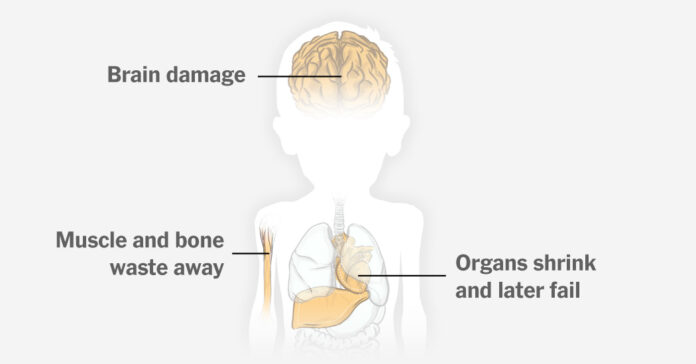When children are deprived of sufficient food, a cascade of health failures can quickly follow. Critical illness and death threaten, and even those who survive may face a lifetime of health challenges.
Young Palestinians, particularly those under age 5, are especially vulnerable in the Gaza Strip, where Israel has imposed restrictions on the entry of aid throughout the war, at times shutting crossings entirely. The highest levels of malnutrition since the war began were reported this summer, and its largest city has been officially declared under famine by a panel of food-security experts.
Food and other critically needed supplies began trickling back into Gaza in May after an 11-week blockade imposed by Israel. It wasn’t enough. In July, food consumption hit its lowest point since the war began, according to the Integrated Food Security Phase Classification, a U.N.-backed group of experts who monitor world hunger.
More aid has gone into Gaza since then. But food shortages remain widespread, and for some of the most vulnerable Gazans, the damage may already have been done.
When children are severely malnourished, their bodies draw on reserves to wage a last-ditch battle for survival. Eventually, their organs begin to break down.
Sometimes they become skeletally thin. Other times they swell up. They can be lethargic to the point of motionlessness, and stop eating even if there is food, because eating takes energy they don’t have. As their defense systems begin to fail, they may die suddenly from common diseases that a healthier child might withstand.
This is what happens to a malnourished body.
When children are experiencing acute malnutrition, most regular foods won’t reverse the process.
The World Health Organization recommends that acutely malnourished children be fed energy-dense foods, such as nut butters and sweet potatoes, and sometimes these can be found locally.
But they are not always readily available in Gaza, where markets and farms have been destroyed. Children there need a specially formulated therapeutic food: an enriched milk, for very young children, or a peanut-based product packed with calories, vitamins and nutrients. The W.H.O. also recommends a broad-spectrum antibiotic to treat infections.
The most seriously malnourished children need to be treated in a hospital, in part because they have no appetite and their bodies are trying to conserve energy. These children are fed specially formulated milk, often through a nasal-gastric tube.
Sharif Matar, a pediatrician at al-Rantisi Children’s Hospital in northern Gaza, said doctors were struggling to cope with a shortage of that enriched milk. While more is available now than even a month ago, health workers still find themselves rationing it to make sure the most severe cases have enough, he said in an interview in late August.
“We are trying to do our best with what we can,” Dr. Matar said. “But in terms of the quality or quantity of what’s available, it’s not enough.”
Throughout the war, Israeli officials have consistently played down the severity of hunger in Gaza. Prime Minister Benjamin Netanyahu’s office called the recent Gaza City famine declaration “an outright lie,” and said the experts behind the famine report had overlooked Israeli efforts since late July to bring more food into the territory.
Aid officials, however, say those measures fall short of what is needed. During the first two weeks of August, the U.N. said nearly 6,000 children out of more than 58,000 screened were found to be acutely malnourished.
Gaza’s doctors are not used to handling such acute malnutrition, said Dr. Matar, as the enclave has never faced a crisis this severe. Some clinicians at his hospital have been taking emergency classes organized by the W.H.O., while others were trying to read whatever they could on how to treat it, he said.
Health officials in Gaza say dozens of children have died of malnutrition since June, but it is not clear how many of them were suffering from both malnutrition and other illnesses or preexisting conditions. Children suffering from malnutrition can be more susceptible to contracting other illnesses, and children with preexisting conditions can be more vulnerable to becoming malnourished, experts say.
Some of the children who get treatment have recovered, including one critically ill 5-year-old girl who was saved with therapeutic milk, Dr. Matar said.
For a child, food is not just energy for the day at hand. It’s the essential building block for a life ahead, needed for the development of muscle, bone and brain.
Even if children experiencing severe malnutrition receive effective treatment and survive, they may suffer from stunted growth, soft bones, liver and kidney problems and cognitive issues. Over the longer term, there may be increased risk of stroke, diabetes and heart disease.
Given the widespread lack of food in Gaza, treating even a single child can at times feel Sisyphean, said Jamil Suleiman, the director of al-Rantisi Children’s Hospital. Some have been released from care to tent encampments where their parents are still struggling to find enough food, Dr. Suleiman said.
“Some of the children we release come back with the same problems a week later,” he said.


